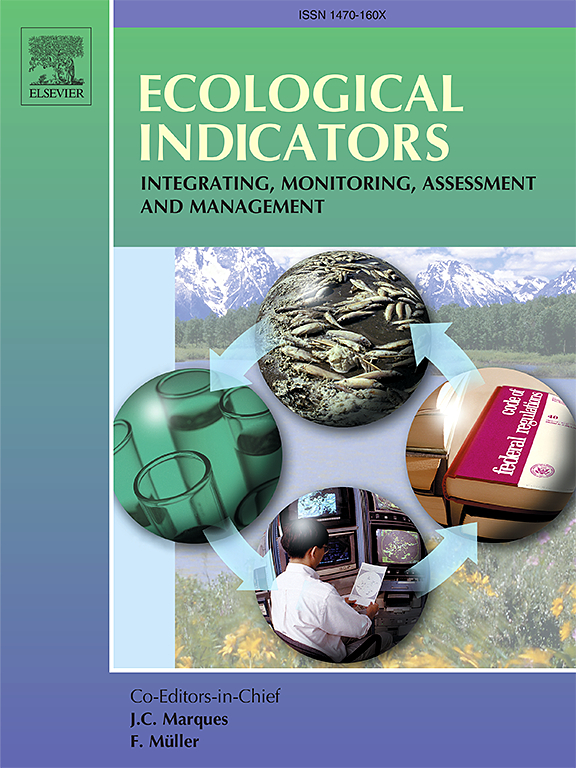评估哈拉红树林的文化生态系统服务:中东沿海海洋保护区可持续管理的指标
IF 7
2区 环境科学与生态学
Q1 ENVIRONMENTAL SCIENCES
引用次数: 0
摘要
伊朗南部的哈拉沿海海洋保护区(CMPA)拥有中东地区最大的红树林生态系统,提供必要的文化生态系统服务(CESs)并支持生物多样性保护。尽管它具有生态和社会文化意义,但日益增加的人类压力和基础设施不足威胁着它的可持续性。本研究评估了当地社区和游客对CES的看法,利用综合社会和生态指标确定了优先的娱乐活动、感知障碍和场地特定的压力源。调查结果显示,当地社区对原CMPA有很强的依赖性,表现出高度的地方依恋和保护承诺。相比之下,游客表现出较低的生态意识,重视审美和娱乐体验,而不是保护问题。红树林、潮汐带和野生动物栖息地等自然特征是最受重视的,而码头和历史村庄等人为改造的地点则被认为不那么重要。基础设施不足和缺乏适当的设施成为利用消费电子产品的最大障碍。在CES的分类中,审美价值排名最高,教育价值排名最低。为了支持哈拉海洋保护区的可持续管理,有针对性的战略应该提高环境意识,升级基础设施,并在规划中纳入当地知识。研究结果提供了一套生态和社会指标,为沿海政策提供信息,强调需要采取包容性的、以利益相关者为中心的方法来平衡海洋保护区治理中的保护和人类活动。本文章由计算机程序翻译,如有差异,请以英文原文为准。
Assessing cultural ecosystem services in the Hara mangrove forests: indicators for sustainable management in a Middle Eastern coastal marine protected area
Hara Coastal Marine Protected Area (CMPA) in southern Iran contains the largest mangrove ecosystem in the Middle East, providing essential Cultural Ecosystem Services (CESs) and supporting biodiversity conservation. Despite its ecological and socio-cultural significance, increasing human pressures and inadequate infrastructure threaten its sustainability. This study evaluates CES perceptions among local communities and tourists, identifying priority recreational activities, perceived barriers, and site-specific stressors using integrated social and ecological indicators. Findings reveal a strong dependence of local communities on the Hara CMPA, demonstrating high place attachment and a commitment to conservation. In contrast, tourists showed lower ecological awareness, valuing aesthetic and recreational experiences over conservation concerns. Natural features such as mangrove forests, tidal zones, and wildlife habitats were most valued, whereas human-modified sites like docks and historical villages were considered as less important. Infrastructure deficiencies and lack of suitable facilities emerged as the most significant barriers to CES utilization. Among CES categories, aesthetic values ranked highest, while educational values received the least recognition. To support sustainable management of the Hara CMPA, targeted strategies should enhance environmental awareness, upgrade infrastructure, and incorporate local knowledge in planning. The findings provide a set of ecological and social indicators to inform coastal policy, emphasizing the need for inclusive, stakeholder-centered approaches to balance conservation and human activities in marine protected area governance.
求助全文
通过发布文献求助,成功后即可免费获取论文全文。
去求助
来源期刊

Ecological Indicators
环境科学-环境科学
CiteScore
11.80
自引率
8.70%
发文量
1163
审稿时长
78 days
期刊介绍:
The ultimate aim of Ecological Indicators is to integrate the monitoring and assessment of ecological and environmental indicators with management practices. The journal provides a forum for the discussion of the applied scientific development and review of traditional indicator approaches as well as for theoretical, modelling and quantitative applications such as index development. Research into the following areas will be published.
• All aspects of ecological and environmental indicators and indices.
• New indicators, and new approaches and methods for indicator development, testing and use.
• Development and modelling of indices, e.g. application of indicator suites across multiple scales and resources.
• Analysis and research of resource, system- and scale-specific indicators.
• Methods for integration of social and other valuation metrics for the production of scientifically rigorous and politically-relevant assessments using indicator-based monitoring and assessment programs.
• How research indicators can be transformed into direct application for management purposes.
• Broader assessment objectives and methods, e.g. biodiversity, biological integrity, and sustainability, through the use of indicators.
• Resource-specific indicators such as landscape, agroecosystems, forests, wetlands, etc.
 求助内容:
求助内容: 应助结果提醒方式:
应助结果提醒方式:


